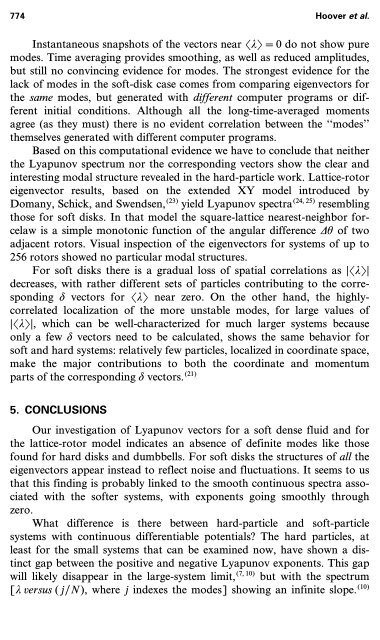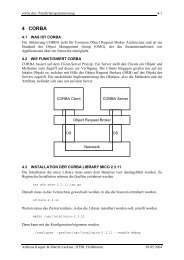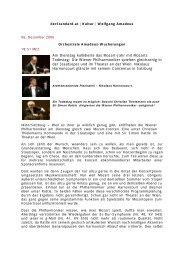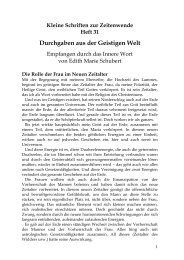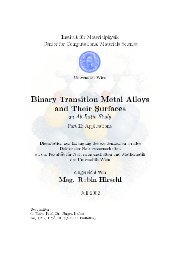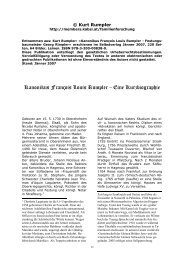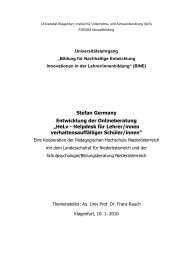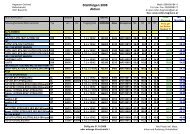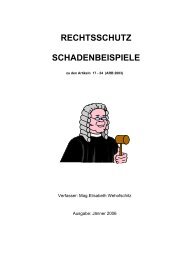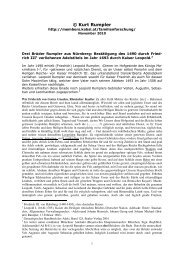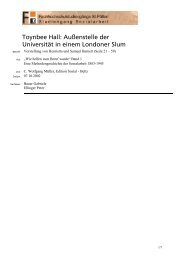Lyapunov Modes of Two-Dimensional Many-Body Systems; Soft ...
Lyapunov Modes of Two-Dimensional Many-Body Systems; Soft ...
Lyapunov Modes of Two-Dimensional Many-Body Systems; Soft ...
Create successful ePaper yourself
Turn your PDF publications into a flip-book with our unique Google optimized e-Paper software.
774 Hoover et al.<br />
Instantaneous snapshots <strong>of</strong> the vectors near OlP=0 do not show pure<br />
modes. Time averaging provides smoothing, as well as reduced amplitudes,<br />
but still no convincing evidence for modes. The strongest evidence for the<br />
lack <strong>of</strong> modes in the s<strong>of</strong>t-disk case comes from comparing eigenvectors for<br />
the same modes, but generated with different computer programs or different<br />
initial conditions. Although all the long-time-averaged moments<br />
agree (as they must) there is no evident correlation between the ‘‘modes’’<br />
themselves generated with different computer programs.<br />
Based on this computational evidence we have to conclude that neither<br />
the <strong>Lyapunov</strong> spectrum nor the corresponding vectors show the clear and<br />
interesting modal structure revealed in the hard-particle work. Lattice-rotor<br />
eigenvector results, based on the extended XY model introduced by<br />
Domany, Schick, and Swendsen, (23) yield <strong>Lyapunov</strong> spectra (24, 25) resembling<br />
those for s<strong>of</strong>t disks. In that model the square-lattice nearest-neighbor forcelaw<br />
is a simple monotonic function <strong>of</strong> the angular difference Dh <strong>of</strong> two<br />
adjacent rotors. Visual inspection <strong>of</strong> the eigenvectors for systems <strong>of</strong> up to<br />
256 rotors showed no particular modal structures.<br />
For s<strong>of</strong>t disks there is a gradual loss <strong>of</strong> spatial correlations as |OlP|<br />
decreases, with rather different sets <strong>of</strong> particles contributing to the corresponding<br />
d vectors for OlP near zero. On the other hand, the highlycorrelated<br />
localization <strong>of</strong> the more unstable modes, for large values <strong>of</strong><br />
|OlP|, which can be well-characterized for much larger systems because<br />
only a few d vectors need to be calculated, shows the same behavior for<br />
s<strong>of</strong>t and hard systems: relatively few particles, localized in coordinate space,<br />
make the major contributions to both the coordinate and momentum<br />
parts <strong>of</strong> the corresponding d vectors. (21)<br />
5. CONCLUSIONS<br />
Our investigation <strong>of</strong> <strong>Lyapunov</strong> vectors for a s<strong>of</strong>t dense fluid and for<br />
the lattice-rotor model indicates an absence <strong>of</strong> definite modes like those<br />
found for hard disks and dumbbells. For s<strong>of</strong>t disks the structures <strong>of</strong> all the<br />
eigenvectors appear instead to reflect noise and fluctuations. It seems to us<br />
that this finding is probably linked to the smooth continuous spectra associated<br />
with the s<strong>of</strong>ter systems, with exponents going smoothly through<br />
zero.<br />
What difference is there between hard-particle and s<strong>of</strong>t-particle<br />
systems with continuous differentiable potentials? The hard particles, at<br />
least for the small systems that can be examined now, have shown a distinct<br />
gap between the positive and negative <strong>Lyapunov</strong> exponents. This gap<br />
will likely disappear in the large-system limit, (7, 10) but with the spectrum<br />
[l versus (j/N), where j indexes the modes] showing an infinite slope. (10)


